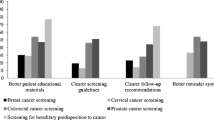Abstract
Given the absence of effective population-based screening tests for ovarian, uterine, vaginal, and vulvar cancers, early detection can depend on women and health care providers recognizing the potential significance of symptoms. In 2008, the Centers for Disease Control and Prevention’s (CDC) Inside Knowledge campaign began distributing consumer education materials promoting awareness of gynecologic cancer symptoms. We investigated providers’ in-office use of CDC gynecologic cancer materials and their recognition of the symptoms highlighted in the materials. We analyzed data from a national 2012 survey of US primary care physicians, nurse practitioners, and gynecologists (N = 1,380). Less than a quarter of providers (19.4 %) reported using CDC gynecologic cancer education materials in their offices. The provider characteristics associated with the use of CDC materials were not consistent across specialties. However, recognition of symptoms associated with gynecologic cancers was consistently higher among providers who reported using CDC materials. The possibility that providers were educated about gynecologic cancer symptoms through the dissemination of materials intended for their patients is intriguing and warrants further investigation. Distributing consumer education materials in health care provider offices remains a priority for the Inside Knowledge campaign, as the setting where women and health care providers interact is one of the most crucial venues to promote awareness of gynecologic cancer symptoms.
Similar content being viewed by others
References
Cancer Education and Awareness Act, HR §1245 (2005)
Su Z, Graybill WS, Zhu Y (2013) Detection and monitoring of ovarian cancer. Clin Chim Acta 415:341–345
Zanotti KM, Kennedy AW (1999) Screening for gynecologic cancer. Med Clin N Am 83:1467–1487
Lockwood-Rayermann S, Donovan HS, Rambo D, Kuo CW (2009) Women’s awareness of ovarian cancer risks and symptoms. Am J Nurs 109:36–45
Koldjeski D, Kirkpatrick MK, Everett L, Brown S, Swanson M (2004) Health seeking related to ovarian cancer. Cancer Nurs 27:370–378
Ryerson AB, Eheman C, Burton J, McCall N, Blackman D, Subramanian S, Richardson LC (2007) Symptoms, diagnoses, and time to key diagnostic procedures among older US women with ovarian cancer. Obstet Gynecol 109:1053–1061
Rim SH, Polonec L, Stewart SL, Gelb CA (2011) A national initiative for women and health care providers: CDC’s Inside Knowledge: Get the Facts About Gynecologic Cancer campaign. J Women’s Health (Larchmt) 20:1579–1585. http://www.ncbi.nlm.nih.gov/pubmed/21933006
Cooper CP, Polonec L, Stewart SL, Gelb CA (2013) Gynaecologic cancer symptom awareness, concern and care seeking among US women: a multi-site qualitative study. Fam Pract 30:96–104
Hawkins NA, Cooper CP, Saraiya M, Gelb CA, Polonec L (2011) Why the Pap test? Awareness and use of the Pap test among women in the United States. J Women’s Health (Larchmt) 20:511–515
Trivers KF, Rodriguez JL, Hawkins NA, Cooper CP, Polonec L, Gelb CA (2011) Intention to seek care for symptoms associated with gynecologic cancers, HealthStyles survey, 2008. Prev Chronic Dis 8:A144
Cooper CP, Polonec L, Gelb CA (2011) Women’s knowledge and awareness of gynecologic cancer: a multisite qualitative study in the United States. J Women’s Health (Larchmt) 20:517–524
Stormo AR, Cooper CP, Hawkins NA, Saraiya M (2012) Physician characteristics and beliefs associated with use of pelvic examinations in asymptomatic women. Prev Med 54:415–421
Saraiya M, Rosser JI, Cooper CP (2012) Cancers that US physicians believe the HPV vaccine prevents: findings from a physician survey, 2009. J Women’s Health (Larchmt) 21:111–117
Stormo AR, Hawkins NA, Cooper CP, Saraiya M (2011) The pelvic examination as a screening tool: practices of US physicians. Arch Intern Med 171:2053–2054
Cumming RG (1990) Is probability sampling always better? A comparison of results from a quota and a probability sample survey. Community Health Stud 14:132–137
Acknowledgments
Funding for this study was provided by the Division of Cancer Prevention and Control, National Center for Chronic Disease Prevention and Health Promotion, Centers for Disease Control and Prevention, which licensed the 2012 DocStyles data analyzed from Porter Novelli (Washington DC). The authors thank Pedro J. Rodríguez, Northrop Grumman Corporation, for extracting the web site materials download data. The findings and conclusions in this report are those of the authors and do not necessarily represent the official position of the Centers for Disease Control and Prevention.
Author information
Authors and Affiliations
Corresponding author
Rights and permissions
About this article
Cite this article
Cooper, C.P., Gelb, C.A., Rodriguez, J. et al. Promoting Gynecologic Cancer Awareness at a Critical Juncture—Where Women and Providers Meet. J Canc Educ 29, 247–251 (2014). https://doi.org/10.1007/s13187-013-0580-z
Published:
Issue Date:
DOI: https://doi.org/10.1007/s13187-013-0580-z




